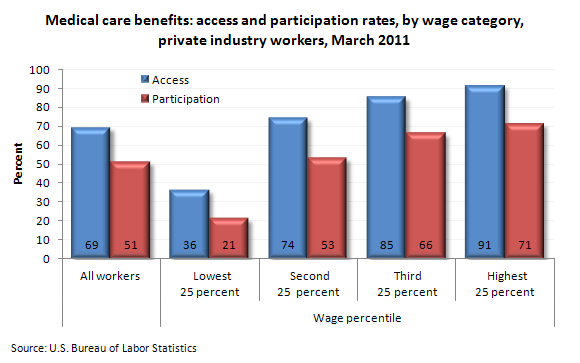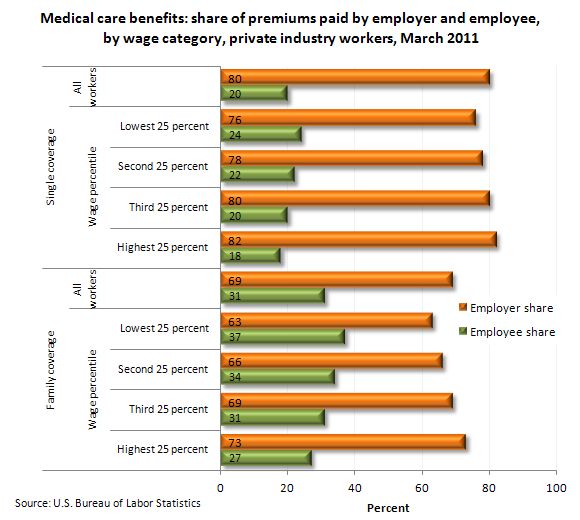January 24, 2012 (The Editor’s Desk is updated each business day.)
Medical care benefits, March 2011
In March 2011, more than two-thirds of private industry workers had access to medical care benefits, and 51 percent of all workers participated in a medical care plan. Employers paid 80 percent of premiums for single-coverage medical care benefits and 69 percent of premiums for family coverage.
Among these workers, access and participation rates varied widely by wage category.

[Chart data]
Higher wage workers (the highest 25 percent of wage earners, at or above $24.81 per hour) had greater access and participation to medical care benefits than lower wage workers (the lowest 25 percent, at or below $10.69 per hour). Access and participation rates for the lowest 25 percent of wage earners were 36 and 21 percent, compared with 91 and 71 percent, respectively, for the highest 25 percent of wage earners.
The share of employer premiums paid for single coverage and family coverage also varied by wage category.

[Chart data]
The share of single-coverage health premiums paid by private industry employers increased from the lowest 25 percent of wage earners to the highest 25 percent of wage earners—ranging from a share of 76 percent to 82 percent. For family coverage, the share of premiums paid by employers ranged from 63 percent to 73 percent, respectively.
These data are from the National Compensation Survey — Benefits program. To learn more, see the Program Perspectives for December 2011, "Health Benefit Costs by Wage Category" (PDF). Employees are considered to have access to a benefit plan if it is available for their use. Participation is the percentage of employees who actually enroll in a benefit plan. Health care is a collective term for the following benefits: medical, dental, and vision care benefits; and outpatient prescription drug coverage. Medical care provides coverage for the treatment and prevention of a broad range of illnesses and injuries, including coverage for surgical care, visits to a physician, or hospital care with inpatient hospital charges.
Related TED articles
Benefits |
Earnings and wages |
Health care
Of interest
Spotlight on Statistics: National Hispanic Heritage Month
In this Spotlight, we take a look at the Hispanic labor force—including labor force participation, employment and unemployment, educational attainment, geographic location, country of birth, earnings, consumer expenditures, time use, workplace injuries, and employment projections.
.
Read more »

